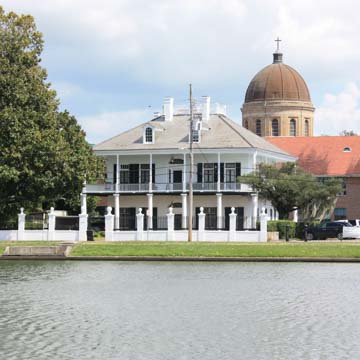As the water link between New Orleans and Lake Pontchartrain, Bayou St. John had some of the city’s earliest habitations along its banks. Although this structure was built later than some, such as the Pitot House (OR73), it has much in common with earlier examples. However, its emphasis on height, its Greek Revival elements, and its central-hall plan clearly reveal the impact of American ideas on Creole forms. Fronted by a two-story gallery supported on heavy Tuscan columns at ground level and turned wood columns above the stuccoed brick house has a hipped roof and widow’s walk. The central front door is set between Ionic columns and sidelights and is topped by a fanlight; the same design is repeated on the floor above. The house was donated to the Catholic Church in 1905 by Evariste Blanc’s descendants, the Denegre family.
You are here
Holy Rosary Rectory (Evariste Blanc House)
If SAH Archipedia has been useful to you, please consider supporting it.
SAH Archipedia tells the story of the United States through its buildings, landscapes, and cities. This freely available resource empowers the public with authoritative knowledge that deepens their understanding and appreciation of the built environment. But the Society of Architectural Historians, which created SAH Archipedia with University of Virginia Press, needs your support to maintain the high-caliber research, writing, photography, cartography, editing, design, and programming that make SAH Archipedia a trusted online resource available to all who value the history of place, heritage tourism, and learning.















